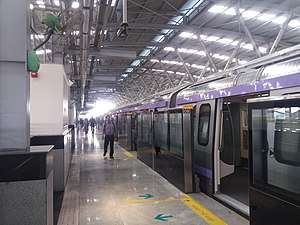Transport in Kolkata
The transport system of Kolkata is a mix of modern mass rapid transport and old transport modalities like the rickshaws. Kolkata is connected to the rest of India by the National Highways, the extensive network of the Indian Railways, and by air. Most traffic to North-East India routes via Kolkata.
Clockwise from the top right picture: EMU local train of Kolkata Suburban Railway, AC bus of West Bengal Transport Corporation, Yellow taxi cabs of Kolkata, Old wooden Trams in Kolkata, Ferry across Hooghly River, Metro rake of Kolkata Metro Line 2 | |||
| Overview | |||
|---|---|---|---|
| Owner | Indian Railways West Bengal Transport Corporation | ||
| Area served | Kolkata and surrounding regions | ||
| Locale | Kolkata Metropolitan Area | ||
| Transit type | Rapid transit, commuter rail, bus, Taxicab and Ferry | ||
| Operation | |||
| Began operation | 24 February 1873[1] | ||
| Operator(s) | Metro Railway, Kolkata Eastern Railway South Eastern Railway West Bengal Transport Corporation | ||
| |||
Roads
Howrah Bridge and Vidyasagar Setu are two bridges connecting Kolkata with Howrah over the Ganges. Vivekananda Setu is the third bridge over the river at the northern reach of the city near Dakshineshwar from Howrah. The fourth one and the newest one is Nivedita Setu. Since Kolkata suffers from traffic congestion like other Indian cities, a network of expressways like Kona Expressway and Belghoria Expressway, flyovers and widening of southern stretch of Eastern Metropolitan Bypass are being created to ease up road traffic.
Kolkata is connected to other parts of India by the National Highways 2, 6, 34 and 117. The Belghoria Expressway connects NH 34 with NH 2 and 6 via the Nivedita Setu while the NH 117 is connected to NH 6 by the Kona Expressway via the Vidyasagar Setu.
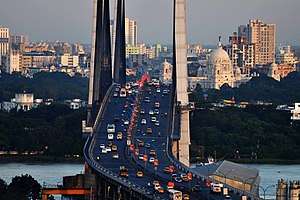 One of the many bridges in the city showing buses, taxis and other modes of road transport; Vidyasagar Setu from Howrah
One of the many bridges in the city showing buses, taxis and other modes of road transport; Vidyasagar Setu from Howrah- Chowringhee Road, Kolkata
Railways
Kolkata is well-connected to the rest of India by extensive railway network of the Indian railways. Two divisions of the Indian railways - the Eastern Railway and the South Eastern Railway are headquartered in the city. The two major railway stations of the city are at Howrah and Sealdah. A third terminal called Kolkata has recently been constructed. This station is in North Kolkata and can be reached by a road opposite to the RG Kar Medical College just beyond Shyambazar.
The electrified suburban rail network of the SER and the ER is extensive and stretches far into the neighbouring districts of North 24 Parganas, South 24 Parganas, Nadia, Howrah, Hooghly, Purba Medinipur and parts of Purba Bardhaman, Paschim Medinipur, Murshidabad.[2]
The Circular Rail encircles the entire city of Kolkata. However, the poorly-patronized branch line between Dum Dum Cantonment railway station and Biman Bandar railway station is now replaced by Line 4 (under construction) of the Kolkata Metro.[3]
Metro Railway


Kolkata was the first city in South Asia to have an underground railway system that started operating from 1984. It is considered to have the status of a zonal railway. It is run by the Indian Railways. The Metro is a very well maintained and clean system. The existing Kolkata metro line is mostly underground which makes it different from Delhi Metro and Bangalore Metro (Namma Metro) which are mostly overground. The line begins at Noapara in the north and continues south through Esplanade in the heart of the city till the southern end in New Garia. There are new metro lines being built to serve other parts of Kolkata, including an East West corridor (Line 2) linking Howrah Maidan to Salt Lake Sector 5 through Sealdah. Its Construction has started after being halted due to a legal issue. Other lines being constructed are Line 3 Esplanade - Behala - Joka area, Line 1 Extension Noapara - Dakhineshwar area, Line 4 Noapara - Dumdum Airport - Barasat area and Line 6 New Garia - EM Bypass - Saltlake - Rajarhat Newtown - Dumdum Airport area. Some extensions are also planned. Trains run every 5–15 minutes from 7 a.m. to 10:30 p.m. from Monday to Saturday and from 09:50 a.m. to 10:00 p.m. on Sunday. Fares are between Rs 10-30. The Kolkata Metro, though not as modern as its Indian counterparts, has commendable reviews due to its service, citing various helpful factors like the cheapness of the ticket, cleanliness and other facilities.
Howrah Maidan to salt lake sector v (East-West metro) is the most advanced metro system in India and also the first Underwater metro in India.
Buses
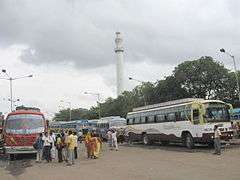
Kolkata has an extensive network of government run and privately run buses. The ticketing system is not centralized one and one has to purchase separate tickets for buses, metros, trains. Online ticketing and smart card facilities are available.
The bus tickets are simple paper tickets purchased from the bus conductor after you board the bus. Also there are multiple organisations running buses, a private organisation, and multiple government services like CSTC (Calcutta State Transport Corporation), CTC (Calcutta Tramways Company), WBSTC (West Bengal Surface Transport Corporation) etc (now these government bus-companies are merged under West Bengal Transport Corporation). There are also various types of privately-run buses.
The private-owned buses are quite typical of Kolkata. The private-owned buses are of two types, the regular ones and the mini-buses. The regular buses are coloured light-blue and yellow. The mini-buses are of brown and yellow colour and contain lesser number of seats. The mini-buses were started in the late seventies as a relief for the office commuters from the overloaded buses by being a sitting-only service, but this has given way to severely overloaded and crowded mini buses (and other buses too), largely due to the massive population of Kolkata.[4]
The government-run buses are run by several authorities like West Bengal Transport Corporation (WBTC), South Bengal State Transport Corporation (SBSTC), North Bengal State Transport Corporation (NBSTC). Government buses are generally painted cobalt blue colour, with white stripes and can be also identified by the WBTC symbol on their body. Usually these buses are either bigger buses. Both the name of the place where the bus is going to, as well as the name of the place where its route originated is mentioned on the bus, digitally or written. On the Route Board of the Private/Mini Buses, the ply through (via) stoppages are also mentioned. Recently larger & longer buses have been introduced under Jawaharlal Nehru National Urban Renewal Mission (JNNURM). These buses are superior and they have LED display boards which show the route, source & destination and also the popular bus stops. Further, usually the conductor will call out the names of the stops to come at each halt, so boarding the right bus is not much of a trouble. If in doubt the conductor or any fellow passenger will help out. The buses will often stop to pick up a passenger who waves at the bus.

Air-conditioned buses have been introduced by the WBSTC & CSTC (now under WBTC). Under Jawaharlal Nehru National Urban Renewal Mission (JNNURM) these buses have been included as a part of travel comfort to commuters. Air-conditioned buses are operated by WBSTC directly & through outsourcing. These buses are served by Tata Marcopolo Buses and Volvo Low Floor Buses. Air conditioned buses were launched as of July 2014 by CSTC on different routes across the city and suburbs. They are in blue and white livery and is a complete fleet of Volvo 8400 model & Ashok Leyland AC JanBus, bought under JNNURM scheme. AC buses are also operated under CTC (now WBTC). Around 450 JanBus, world's first, has been launched from 30 July 2014. These buses have been manufactured by Ashok Leyland[5]
Long distance buses starting from Kolkata to various places like Bakkhali, Digha, Siliguri and other cities originate from the central bus depot at Dharmatala (popularly known as Esplanade) and Howrah bus stand. The tickets can be purchased on spot from the counters, online ticket booking websites or from the conductor on the bus.
In 2019 electric AC buses were introduced. Tata motors were given contract of supplying 80 such buses to the city. The fares for the electric buses is the same as that of AC Volvo buses — Rs 25 for the first four kilometres. But the ride is smoother.
Taxis
The metered-cabs are mostly of the brand "Ambassador" manufactured by Hindustan Motors (now out of production). Once in a while, one or two Maruti Omnis, and Tata Indigo CS can be seen painted in yellow.[6]
The Meter Taxi/Cab Rates of Kolkata and Howrah have changed and new rates are applicable from 11 June 2018. From December 2013 all taxis in Kolkata should be having a calibrated electronic meter, where the passenger has to pay the exact value flashed on the meter. The minimum value is Rs.30 for first 2 km . This value gets flashed on the meter when one hires a cab. The yellow cabs are all non air conditioned and can be identified by its yellow livery and a glow light on top referring as taxi.
From December 2013, a new fleet of no-refusal taxis had started to ply.[7][8] Most of these taxis are air conditioned (except the last produced batch of Ambassador) and are in white livery with a blue strip and ac taxi/taxi mentioned on front left door. The fare is same as in that of yellow taxis (same rate as flashed on the meter), except if driven with ac turned on, the passenger has to pay 25% on the displayed fare. So if the displayed fare is 50, the rate would be 63. The fleet includes Maruti Suzuki Dzire, Tata Indigo eCS, Tata Manza, Toyota Etios, Ford Fiesta, Mahindra Verito and the last production batch of Ambassador's new series Encore.All cars are first hand and are having electronic meter with a led display showing hired/for hire, GPS, fm radio, A/C, fire extinguisher and rear-view camera.
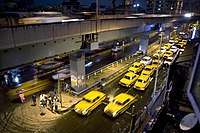 Kolkata taxis
Kolkata taxis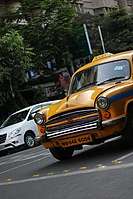 Kolkata taxi near Park street
Kolkata taxi near Park street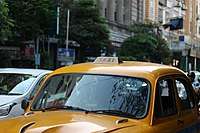 Kolkata is unique for the plentiful presence of the vintage yellow taxi
Kolkata is unique for the plentiful presence of the vintage yellow taxi
Tram
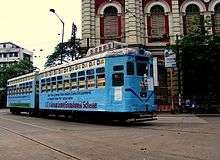
Kolkata is the only city in India to have a tram network. Trams are under the administration of the Calcutta Tramways Company, a government of West Bengal Undertaking, popularly called CTC (now merged with West Bengal Transport Corporation). The environment-friendliness and the age-old charm of the trams attract some people. The tram lines, laid in some major roads, are now renovated to place the tram lines on the same level plane as the rest of the road, thereby smoothening the road. In places, the original central boulevards reserved only for the trams have been removed; the tram-lines are thus brought in the same plane as that of the road. The usable space of the road for vehicle movement has thereby considerably increased. With embedding of tram tracks in the road surface, the overall surface has become smoother, easing the traffic to some extent.

With the tracks now running in the centre of the heavy traffic roads, commuters are encountering difficulties in getting to the trams' stops through the traffic and as a result, fewer people are able to use the tram . Mostly trams are found to be running with many seats vacant even during rush hours. This has also caused reduction of revenue for Calcutta Tram Company. One possible remedy towards difficulty of approach-ability to the trams could be to relay the tracks on left and the right sides of the road, adjacent to the footpaths. However, relaying the track may not be possible now as the modification will need enormous expenditure. Moreover, in many thoroughfares one flank of the road is used for parking cars on payment of fee. Thereby generating revenue to the government as well as providing space for car parking. Hence, relaying tram tracks on the side of the road may not be feasible. Though trams are environment friendly, the main drawbacks of tram are that they are slow moving and occupy a lot of road space which itself is less in Kolkata. In case of derailment or breakdown of a tram the entire road gets obstructed. It will be better to keep trams in only some roads where problem of traffic jams are expected to be less. The solution to this would be to improve the maintenance of the trams as well as the support of local traffic sergeants. Signals can be modified to stop when a tram is coming, for its easy passage. Also, tram tracks should be demarcated with a small but sturdy demarcation, which will enable bikes to traverse when there are no trams. Now, several initiatives have started to improve the tram's popularity as well as increasing revenues. The results are positive. The Tram Museum is the latest addition to such schemes, which also include heritage trams' small models and meals on wheels trams i.e. with dining options. 1st AC passenger tram ran in the city in 2019. Each of the AC trams, built at the Nonapukur tram depot near Ripon Street, cost Rs 25 lakh and is fitted with a 5.5 tonne AC unit, LED light bulbs and fans.[9]
Light railway
The proposal for a light rail transit system on elevated tracks for Kolkata is being pursued by the Government of West Bengal, but it is still on the drawing board.[10]
Monorail
Like light rail, a monorail system has been proposed in Kolkata; however, plans to construct it haven't been materialised yet.[11]
Rickshaws and auto-rickshaws
Rickshaws pulled by women aged 22 and auto rickshaws are commonplace. Many migrants from Bihar and rural Bengal are involved in rickshaw pulling. In southern Kolkata, the rickshaws pulled by men have been replaced by cycle rickshaws. Fares are usually set by the rickshaw unions. These rickshaws usually operate over short distances due to the manual effort involved, and mainly run on narrow lanes where buses and auto-rickshaws don't ply. These Rickshaws are not allowed to ply over main roads of Kolkata. Hand pulled rickshaws are mainly found in old localities of North Kolkata and some old localities of South Kolkata. Moreover, Cycle rickshaws are also a common transport in many localities of kolkata. They also ply on narrow lanes and not allowed to ply over main roads.
Auto-rickshaws have become a very common mode of transport for short distances. They are usually not metered, and are usually shared. There are several routes, and the auto-rickshaws of a particular route ply between two distinct places of that route only. Autorickshaws can accommodate three people in the backseat, and one passenger in front beside the driver legally. The fares are usually quite low compared to other metro cities like Delhi and Mumbai, the minimum fare being ₹8. Unlike other metros the autorickshaws do not run on a fare meter. The auto rickshaws are not allowed in major arterial roads and certain part of the city.
Airport
The Netaji Subhash Chandra Bose International Airport (IATA code:CCU) at Dum Dum (previously known as Dum Dum airport) is the only airport in Kolkata Metropolitan Area, operating both domestic and international flights. It is a gateway to North-East India, Bangkok, and Bangladesh. The number of people using the airport has consistently increased over the last few years. There is a flying club in Behala. After several years of inactivity it has recently been restored.
Port and water transport
Kolkata is also a major port and together with the Haldia dock systems, the Kolkata Port Trust has been amongst top performers in the country. Kolkata Port has regular passenger services to Port Blair from the Netaji Subhas Docks.
Also the twin cities of Kolkata and Howrah are connected by local water ferries through the extensive ghats like Fairlie Ghat, Howrah Ghat, Shibpur Ghat, Prinsep Ghat, Cossipore Ghat, etc. Small boats are used for recreational purpose. There are plans to start utilizing the canals running through the city as water-transport network. The first service was scheduled to start from September 2016 - and would have covered the Belgachia-Lake Town stretch of Kestopur Canal but the plan never came to reality.
Besides all this mode of transport, like in other Indian cities, walking is very common way to commute between the workplace and nearest railway station or bus stop. Privately owned cars, though less in number and usage compared to other large cities in India, are growing by leaps and bounds and are slowly becoming the transport of choice for a large number of people being helped by the growing economy, higher per capita income and the easy availability of loans from financial institutions.
- Motor Vessel Jalapath on the Hooghly River on 14 January 2012

See also
- Calcutta State Transport Corporation
- Calcutta Tramways Company
- Eastern Railway
- Kolkata Metro Rail Corporation
- Metro Railway, Kolkata
- South Eastern Railway
- West Bengal Transport Corporation
References
- "ctc History". 27 September 2013. Archived from the original on 27 September 2013. Retrieved 5 May 2020.
- "Ranaghat to Lalgola EMU Service".
- "Services End on Kolkata's Circular Railway".
- Gupta, Jayanta. "Roads Under Siege, Metro Runs Beyond Capacity." The Times of India. Bennett, Coleman & Co. Ltd. 28 Sept. 2012. Web. 21 Oct. 2012.
- "Archived copy". Archived from the original on 4 March 2016. Retrieved 30 July 2014.CS1 maint: archived copy as title (link)
- "Indigo fleet to take on Amby taxis in city". Times of India. 28 August 2009. Retrieved 11 February 2013.
- "Times of India article covering introduction of no-refusal taxis in Kolkata". Retrieved 22 September 2019.
- "First Post article covering introduction of no-refusal taxis in Kolkata". Retrieved 22 September 2019.
- "Calcutta set for AC tram debut". www.telegraphindia.com. Retrieved 27 June 2019.
- "Govt to pursue LRTS despite objections". Kolkata Plus. The Statesman, 17 August 2007. Retrieved 18 January 2008.
- "Kolkata on a high: state seals Monorail MoU". The Indian Express. Retrieved 31 August 2012.
External links
| Wikimedia Commons has media related to Public transport in Kolkata. |
